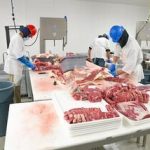Over 1.5 million jobs are available in the meat/fish/poultry job market in the United States. The industry covers many jobs in meatpacking plants, slaughterhouses, processing facilities, and distribution establishments. This industry also offers many job opportunities across other various sections.
Grandview Research predicts that the U.S. meat/fish/poultry market will grow to $215.76 billion by 2028. It also has a 3.21% growth rate from 2021 to 2028. This sector is important because it provides high-quality animal protein and food security. It will also produce 17,500 job openings every year for the next 10 years.
Overview of the Meat/Fish/Poultry Job Market
The meat/fish/poultry industry is a vital source of protein for many people around the world. According to the World Bank, the livestock sector employs about 1.3 billion people across the globe. This makes it one of the largest employers in the agricultural sector.
The industry faces challenges in terms of labor shortages and attracting new workers despite its size. The aging workforce, safety concerns, and physical demands of many jobs contribute to the shortage of skilled workers in the industry. Additionally, changing consumer preferences toward plant-based diets and animal welfare concerns influence the industry’s growth.
Most Common Available Jobs in the Meat/Fish/Poultry Industry
The meat/fish/poultry industry provides global food security, which makes it highly in demand. It creates many employment opportunities, and to land the best jobs in this sector, you must know the available jobs.
10 most common available jobs in the meat/fish/poultry industry include:
1. Research and Development Scientists (R&D)
Average Annual Salary: $125,000

Research and development scientists conduct studies and experiments to develop new food products. They perform tests, streamline product requirements and guidelines, and assess the results.
Communication, analytical skills, data analysis, laboratory proficiency, and knowledge of regulatory requirements are necessary for this position.
A research and development scientist must possess a bachelor’s degree in any relevant field. Many employers prefer individuals who have years of working experience.
Scientists working in research and development have a promising job outlook, with a 5% increase in employment expected between 2020 and 2030. In the US job market, there are now 129,803 opportunities for this position.
2. Industrial Production Managers
Average Annual Salary: $107,970
Industrial production managers ensure the daily operations of manufacturing go well. They spend some of their time in an office and some of it in the production area. They make sure the meat/fish/poultry are prepared according to their company standards.
Good communication, interpersonal, and leadership skills are relevant in this sector. They must know production processes, quality control, and safety standards.
An industrial production manager must have a bachelor’s degree in any related field. Additionally, they should have several years of related work experience.
The job outlook for this role will grow by 3% from 2020 to 2030. It will produce many employment opportunities due to the need to replace workers who retire or leave.
3. Veterinarians
Average Annual Salary: $100,370
Veterinarians care for the health of animals. They diagnose, treat, and research medical conditions and diseases in them. They perform surgeries, dress wounds, prescribe medications, take X-rays, and much more.
A veterinarian must have competency in math, science, language, and research. Additionally, they should be educated in animal science, biology, chemistry, and anatomy.
Employers require a Doctor of Veterinary Medicine degree from an accredited college. They must also have their license.
The job outlook for this role will grow by 19% in the next ten years. There will be 4,800 job openings for veterinarians each year for the next 10 years.
4. Agricultural Engineers
Average Annual Salary: $80,720
Agricultural engineers design and develop new equipment, machinery, and structures to improve the efficiency of meat/fish/poultry production. They combine various disciplines of mechanical, food science, environmental, and chemical engineering to ensure the sustainability of natural and renewable resources.
An agricultural engineer must possess strong problem-solving and analytical skills to identify and solve complex problems. Additionally, you need to be proficient in using engineering software and tools.
The educational requirement for this role is a bachelor’s degree in an engineering or biological field. The Bureau of Labor Statistics predicts a 2% growth rate from 2021 to 2031. This role will promise many employment opportunities in the coming years.
5. Quality Control Specialists
Average Annual Salary: $75,000
 A quality control specialist inspects products in the meat/fish/poultry sector to check for defects. They also ensure that products meet the required quality standards, identify areas for improvement, and guarantee consumer satisfaction.
A quality control specialist inspects products in the meat/fish/poultry sector to check for defects. They also ensure that products meet the required quality standards, identify areas for improvement, and guarantee consumer satisfaction.
You need a blend of hard and soft abilities to land this position. Product testing, process improvement, documentation, attention to detail, labeling, and sampling are considered hard skills. Interpersonal, leadership, problem-solving, and communication skills fall under the category of soft skills.
Quality control specialists must have a bachelor’s degree in food science and technology, engineering, or a related field. Nonetheless, some companies hire individuals with a high school degree.
The job outlook for quality control specialists is positive. It has a growth rate of 5% from 2020 to 2030. This role will produce many employment opportunities due to the growing demand for quality products and services.
6. Food Scientists and Technologists
Average Annual Salary: $72,570
Food scientists and technologists study the basic elements of food using chemistry, biology, and other related stuff. They investigate novel food sources, examine food’s nutritional value, and look for ways to make processed foods wholesome and safe. They also create fresh or improved methods for choosing, preserving, processing, packaging, and distributing food.
A food scientist and technologist require strong analytical, problem-solving, and critical-thinking skills. They possess knowledge of food processing, preservation, and packaging techniques.
A bachelor’s degree in food technology, food science, or food engineering is the minimum needed for becoming a food scientist or technologist. However, employers prefer candidates with a master’s or doctoral degree in food science or a connected discipline.
The job outlook for food scientists and technologists is positive, with a 6% growth rate for the next 10 years. CareerExplorer projects 1,200 job openings every year in the future.
7. Wholesale and retail buyers
Average Annual Salary: $66,790
Wholesale and retail buyers buy meat/fish/poultry products and sell them to consumers at the wholesale or retail level. To estimate value and yield, they examine historical purchasing patterns, sales figures, product prices, and product quality. They also hold meetings with sales representatives, present new items, and negotiate contracts.
A wholesale and retail buyer must know about typical pricing and standards within their industry. Additionally, they need strong mathematical and coordination skills.
Employers want individuals with a bachelor’s degree in business, economics, or a related field for this role. They also receive on-the-job training.
According to the BLS, the job outlook for this role will decline by 6% from 2021 to 2031. This position will also produce fewer jobs in the next few years.
8. Sales Representative
Average Annual Salary: $65,690
A representative of a meat/fish/poultry company contacts customers to solicit business by promoting their products. They create sales pitches, conduct cold calls, provide presentations, strike deals, and work toward their sales objectives.
An effective salesperson possesses excellent interpersonal and communication abilities. It makes it easier for them to explain the aspects of the product, respond to consumer inquiries, and explain how the good or service operates.
Sales representatives must possess a high school diploma or its equivalent as a minimum. A bachelor’s degree in a relevant subject, such as business, marketing, or communications, is nevertheless required by some employers. To learn about the products, they are selling, the sales process, and customer service methods, employees in this position must complete on-the-job training.
According to the US Bureau of Labor Statistics, this role has a growth forecast of 5% from 2018 to 2028. 1.3 million sales representatives are working in the United States, and this position will produce more jobs in the next 5 years.
9. Zoologists and wildlife biologists
Average Annual Salary: $65,500
Zoologists and wildlife biologists study animals, their origins, behaviors, diseases, habitats, life cycles, and population structures.
Strong analytical, critical thinking and problem-solving abilities are skills zoologists and wildlife biologists must possess. Also, they should know scientific research methods, data analysis, and statistical software.
A zoologist or wildlife biologist needs a bachelor’s degree in zoology, wildlife biology, or a related field. The job outlook for this role is 1% over the next ten years. According to CareerExplorer, there will be 17,100 employment opportunities for this position in the next few years.
10. Fish and Game Wardens
Average Annual Salary: $60,200

Fish and game wardens specialize in enforcing hunting, fishing, and boating laws. They manage land, lakes, and wildlife programs and patrol assigned areas. Additionally, they look into fishing or hunting infractions and hunting accidents, and they could gather proof to testify in court.
A fish and game warden needs excellent communication and interpersonal skills, with knowledge of fish, wildlife, and natural resource management. They must also possess knowledge of conservation management, botany, and wildlife biology.
Companies hire individuals with a bachelor’s degree in a relevant field for this role. They also need to complete a training program at a law enforcement academy.
The job outlook for fish and game wardens will grow by 1% in the next ten years. CareerOneStop predicts that this role will produce 6,900 by 2031.
Other jobs available Meat/Fish/Poultry
- Supervisors of farming, fishing, and forestry workers (Average Annual Salary: $50,540)
- Steward – (Average Annual Salary:$49,740)
- Animal breeders (Average Annual Salary:$43,190)
- Food science technicians (Average Annual Salary:$43,190)
- Production Workers (Average Annual Salary: $40,000)
Most Common Available Entry-Level Jobs in the Meat/Fish/Poultry
Meat/Fish/Poultry offers a variety of entry-level jobs for those interested in working in the industry. All of them offer worthwhile possibilities and experiences.
5 most common available entry-level jobs in the meat/fish/poultry include:
1. Truck drivers
Average Annual Salary: $43,220

Truck drivers drive vehicles used in the delivery of meat, fish, and poultry products. They pick them up from the production outlets or a distribution center and deliver them to consumers.
A truck driver must have essential truck driver skills, including organizational, mechanical, and superb navigation abilities.
Many employers prefer candidates with a high school diploma or equivalent. Truck drivers must also have a valid commercial driver’s license (CDL), a good driving record, and the ability to operate and maintain a vehicle safely.
This role will grow by 11% from 2021 to 2031. In the next ten years, there will be an average of 219,900 job opportunities for truck drivers.
2. Animal Breeders
Average Annual Salary: $43,190
Animal breeders select and breed animals based on their genealogy, characteristics, and offspring. They also use artificial insemination techniques and equipment and keep records on heat, birth intervals, and pedigrees.
To get this role, you must have knowledge of the animal breeding process and its potential risks. Also, you must communicate effectively and know how to manage your time.
An animal breeder does not need a formal education. However, many employers require two years at a technical school or a college diploma.
The job market for this role will grow by 2.2% from 2016 to 2026. It will also produce 7,180 new jobs by 2029.
3. Animal Caretakers
Average Annual Salary: $40,090
Animal caretakers take care of animals and promote and maintain their well-being. They also keep records of feedings, treatments, and animals received or discharged.
An animal caretaker must have good communication skills be physically fit, and love animals. Also, they need effective communication skills, reading skills, and critical and creative thinking abilities.
The educational qualification required for this job is a high school diploma or equivalent. However, some employers prefer candidates with experience working with animals.
The job outlook for animal caretakers is positive, with a growth rate of 24.2% from 2016 to 2026. In the next 10 years, the US will produce 66,600 employment opportunities for this role.
4. Meat Cutters and Butchers
Average Annual Salary: $36,000
Meat cutters and butchers cut, trim, and prepare meat for sale or consumption. They use their hands or hand tools to perform routine cutting and trimming of meat, poultry, and seafood.
To become a meat cutter and butcher, you must know animal anatomy and meat-cutting techniques. The ability to use knives and other cutting tools with physical stamina and hand-eye coordination is relevant.
A meat cutter and butcher does not need any formal education. However, some companies offer on-the-job training or an apprenticeship.
The job outlook for meat cutters and butchers will decline by 3% from 2021 to 2031 due to technology. Nonetheless, this role will produce 17,700 employment opportunities every year for the next 10 years.
5. Food Batchmakers
Average Annual Salary: $31,860

Food batchmakers set up and operate equipment that mixes or blends ingredients used in the manufacturing of food products. They mix ingredients, load and unload ovens, and perform tasks specific to large-scale operations.
A food batchmaker must have attention-to-detail skills, physical stamina, and the ability to work in a fast-paced environment.
Although educational requirements differ, many hirers demand a high school diploma or its equivalent. They also offer on-the-job training, which lasts a few weeks to a few months, and workers learn on the job.
This position will grow by 4% from 2021 to 2031. It will also produce about 36,700 openings per year for the next 10 years.
What is the Job Description of a Meat/Fish/Poultry Professional?
Meat/fish/poultry employees procure, prepare, and distribute meat, fish, and poultry products for various industries. Their job descriptions differ according to the specific role and the type of product.
5 specific responsibilities of employees in meat/fish/poultry:
1. Procurement and Inventory Management
Meat, fish, and poultry experts procure high-quality raw materials and manage inventory to ensure that sufficient quantities are available for production. They evaluate market trends, negotiate with suppliers, and maintain accurate records of shipments.
2. Quality Control
They ensure that meat, fish, and poultry products meet industry standards and regulations. Also, they inspect incoming raw materials, implement safety and sanitation procedures, and monitor the production process.
3. Production Planning and Management
Meat/fish/poultry professionals plan and manage production schedules to meet customer demands and deliver products early. They coordinate with other departments, manage staff schedules, and oversee the production process from start to finish.
4. Equipment Maintenance
Workers in this sector ensure that all manufacturing equipment undergoes proper maintenance to avoid any breakdowns or safety hazards. They also conduct routine inspections, perform repairs, and ensure that all equipment is functioning properly.
5. Customer Service
They maintain good relationships with customers and respond quickly to any concerns or complaints. To understand the needs of the consumer and offer them high-quality goods and services, they must communicate clearly with them.
How to Get a Job in Meat/Fish/Poultry?
If you are interested in the meat/fish/poultry industry, working there will be a good fit. However, you need practical steps and tips that will help you land your dream job in this industry.
5 important steps you can take to get a job in the meat/fish/poultry industry:
1. Obtain relevant education and training
You need a good educational background to get a job in the meat, fish/poultry industry. This includes getting a degree in animal science or food science engineering. Some companies will demand that you undergo training programs or an apprenticeship to get real-world experience.
2. Obtain necessary certifications and licenses
Depending on the role you are interested in, you need to have relevant education and training. Consider getting a degree or certification in fields like animal science, food science, or culinary arts. You can also enroll in apprenticeship programs or on-the-job training opportunities.
3. Determine your career goals
There are many job opportunities in the meat/fish/poultry. You must sit down, think, and identify which specific job you want to take in the industry. It will guide you in tailoring your CV/resume and job search.
4. Gain practical experience
Many employers in the meat/fish/poultry industry require job applicants to have some practical experience. You may need to work in the sector as an intern, apprentice, or entry-level employee. This will increase your chances of getting a job.
5. Apply for jobs
Start applying for the roles you want when you have the necessary education, training, and experience. Look for job openings on online job boards, company websites, and professional associations.
How to get an entry-level job in meat/fish/poultry?
Getting an entry-level job in the meat/fish/poultry industry can be a great way to start in this field. It also provides opportunities for growth and advancement over time.
5 basic steps to get an entry-level job in meat/fish/poultry:
1. Identify the type of job you want
You must identify the type of job you want in the meat/fish/poultry industry. There are entry-level positions available in production, packaging, quality control, and distribution. Determine the type of job you want and the skills required for the role. It will help you focus your job search and tailor your resume and cover letter to the specific job you are applying for.
2. Get the necessary education and training
Although formal education is not always required for entry-level positions in the meat/fish/poultry industry, many companies prefer candidates with a high school diploma or GED. Some positions also require on-the-job training, while others require certification from a trade school or vocational program. Research the specific job requirements and education/training options available to you.
3. Look for job openings
Check online job boards, local classifieds, and company websites to find entry-level job openings in the meat/fish/poultry industry. You can also reach out to local staffing agencies that specialize in this sector. Make sure you read the job description carefully and ensure that you meet the requirements before applying.
4. Create a compelling resume and cover letter
Your resume and cover letter should highlight your skills and experience working in a fast-paced environment or following food safety protocols. Tailor your resume to the specific job you are applying for, and use keywords from the job description to help your application stand out. Also, proofread your resume and cover letter for spelling and grammar errors.
5. Apply for jobs and be flexible
Apply for many entry-level jobs and be willing to start at the bottom. You must be flexible in terms of location and schedule because many entry-level jobs require working long hours and spending time in the factory.
Additional tips for finding available jobs in meat/fish/poultry
Here are 3 additional tips for finding jobs in meat/fish/poultry:
1. Demonstrate a strong work ethic
You must demonstrate a solid work ethic and a desire to learn and advance in the field. Even though entry-level positions might not pay well, you can develop yourself in the meat/fish/poultry sector. Prepare to work hard, take on new challenges, and have a cheerful outlook. This will assist you in moving up the ranks and achieving your professional objectives in this field.
2. Be flexible
Entry-level jobs in the meat/fish/poultry industry will require you to work early mornings, late nights, weekends, and holidays. Be prepared to work a flexible schedule and adapt to changing work conditions.
3. Show enthusiasm and passion
Employers in the meat/fish/poultry industry are looking for employees who are enthusiastic and passionate about their work. Show your employer that you are excited about the job and the industry, and be willing to go the extra mile to exceed expectations.
How many job positions are there in meat/fish/poultry?
There are many different job positions available in the meat/fish/poultry industry, ranging from entry-level positions to highly skilled roles. Some entry-level positions are production workers, packagers, and quality control inspectors. More expert roles include meat cutters, butchers, and food scientists. Additionally, the sector has jobs in sales, marketing, distribution, and logistics.
Which meat/fish/poultry job is easy to get?
Truck drivers, animal breeders, food batchmakers, meat cutters, and butchers are easy to get into because they typically don’t require extensive prior experience or formal education beyond a high school diploma or equivalent.
What are the Educational Requirements and Training for Meat/Fish/Poultry?
The educational requirements and training for the meat/fish/poultry industry differ depending on the job position, the country, or the region. However, there are educational and training requirements for many job positions in this sector.
7 educational and training requirements for meat/fish/poultry:
Education
1. High School Diploma
Many entry-level positions in meat/fish/poultry require a high school diploma or an equivalent, such as a GED. Job applicants with this qualification have writing, numeracy, and critical thinking skills. These form the bare minimum.
2. Bachelor’s Degree
Employers require a bachelor’s degree for positions like research and development scientist and food technologist. Degrees provide a more in-depth understanding of the industry and the technical skills for these positions.
3. Master’s Degree
Many jobs benefit from an associate’s degree in any field related to the meat/fish/poultry sector. This degree offers a foundation and helps individuals land a more advanced position in the industry.
Training and Certifications
4. On-The-Job Training
Employers offer on-the-job training for many roles in the meat/fish/poultry sector. This training usually lasts from one to six months. It provides new employees with the basic skills and safety procedures they need.
5. Vocational Training
Some roles in the industry require vocational or technical training. For example, meat cutters and butchers need to complete a vocational training program to learn how to properly cut and prepare meat products.
6. Good Manufacturing Practices (GMPs)
GMPs are guidelines for ensuring that food products are safe, pure, and effective. This training is often required for jobs in food processing, packaging, and distribution.
7. ServSafe
Workers are taught proper handling and preparation techniques for food products through the ServSafe safety training program. This certification is frequently required for positions in the food service industry, notably those in delis or restaurants serving meat, fish, or poultry.
Where Do I Find Meat/Fish/Poultry Jobs?

If you are looking for job opportunities in the meat/fish/poultry industry, there are several job boards and websites that can help you find relevant job listings. These job boards are focused specifically on the meat, fish, and poultry industry, and are great resources.
5 major job boards to find a job in meat/fish/poultry:
1. Meatjobs.com
This job board posts employment opportunities in processing, production, quality control, and sales. The website shares job listings from companies across the United States and also adds resume tips and industry news.
2. Meatpoultry.com
For the meat, fish, and poultry industries, this website offers job listings and focuses on news and information about the sector. They feature job postings for positions in management, production, processing, and other departments related to the meat and poultry business.
3. SeafoodSource.com
This website contains job listings for the seafood industry. The site also includes news and information about the seafood sector and relevant resources for job seekers.
4. AgHires.com
This job board includes listings for agricultural and food-related jobs, especially those in the meat, fish, and poultry industry. They share employment opportunities from companies across the United States and resources like career advice and resume tips.
5. Careersinfood.com
This website shares job listings for food-related industries. The job categories they have include production, quality control, management, and sales.
What are the Skills Needed to Get a Job in Meat/Fish/Poultry?
You must have skills relevant to the meat/fish/poultry industry. These skills will increase your chances of landing a job in the sector.
5 essential skills needed to get a job in meat/fish/poultry:
1. Knowledge of industry regulations
The meat/fish/poultry industry is heavily regulated, and workers must have a good understanding of industry regulations and standards to comply with them. This includes knowledge of food safety regulations, as well as environmental and health and safety regulations.
2. Knowledge of food safety and sanitation
Workers in the meat/fish/poultry industry should know about food safety and sanitation protocols to prevent contamination and ensure foods are safe for consumption. They must understand proper handling, storage, and cooking temperatures, and the use of equipment and cleaning products.
3. Understanding of animal anatomy and processing techniques
Roles that involve processing or butchering meat/fish/poultry products must understand animal anatomy. They should be able to use processing techniques to prepare products with knowledge of cutting meat and preparing different parts of an animal using knives and other equipment.
4. Technical and mechanical skills
Depending on the role, workers need to use specialized machines to process and package meat/fish/poultry products. This makes technical and mechanical skills necessary. This includes the ability to operate and maintain equipment such as slicers, grinders, and packaging machines.
5. Physical fitness and dexterity
Most jobs in the meat/fish/poultry industry are physically demanding, like lifting heavy objects or working in cold, wet environments. Therefore, physical fitness and dexterity are important skills to have. Workers must be able to stand for long periods, move quickly and safely, and be able to lift and carry heavy items.
What are the Factors Affecting the Availability of Jobs in Meat/Fish/Poultry?
The meat/fish/poultry sector can be affected by various factors that influence the availability of jobs in the industry. Knowing these factors is important for job seekers looking to work here.
5 major factors affecting the availability of jobs in the meat/fish/poultry sector:
1. Economic Conditions
Economic conditions always have significant impacts on the availability of jobs in the meat/fish/poultry sector. When the economy is strong, the demand for meat/fish/poultry products is high. This leads to increased production and more job opportunities. On the other hand, when the economy is weak, there will be less demand for these products, which leads to a reduction in production and job opportunities.
2. Technological Advancements
The meat/fish/poultry industry evolves constantly, and advancements in technology have a significant impact on the availability of jobs. Now, automation and robotics are increasingly being used in processing plants, and this leads to a reduction in the number of human workers needed.
3. Industry Consolidation
The meat/fish/poultry industry has a small number of large companies, and consolidation in the industry impacts the availability of jobs. When companies merge or acquire other companies, there will be redundancies and job losses as the new company streamlines operations.
4. Consumer Demand
Consumer demand for certain types of meat/fish/poultry products can have an impact on job availability. For example, if there is increased demand for organic or sustainably-raised products, there will be more job opportunities in these areas.
5. Geographic Location
The availability of jobs in the meat/fish/poultry sector can be affected by geographic location. Some regions have a higher concentration of processing plants and other facilities, which leads to more job opportunities. Equally, it can also be influenced by other factors like local labor market conditions and the cost of living in a particular area.
Conclusion: How Many Jobs are Available in Meat/Fish/Poultry?
The meat/fish/poultry sector is a dynamic and evolving industry that offers a range of job opportunities for those interested in working in this field. People with the right skills and educational requirements can land a job in this sector. Furthermore, with the increasing demand for organic and sustainably-raised products, new job opportunities are available in these areas.
FAQ: How Many Jobs are Available in Meat/Fish/Poultry?
What is the most common job in meat/fish/poultry?
Food technologists and scientists, zoologists, sales representatives, veterinarians, and fish and game wardens are the most common jobs in meat/fish/poultry.
Are there a lot of jobs in meat/fish/poultry?
Yes, there are many jobs available in the meat/fish/poultry industry.
Are meat/fish/poultry easy?
The meat/fish/poultry sector can be physically demanding and involve working in cold or wet conditions. This can be challenging for some individuals.
What is the hardest meat/fish/poultry job to get?
Processing plant managers, research and development scientists, and quality assurance managers have the most challenging jobs in the meat/fish/poultry industry.








